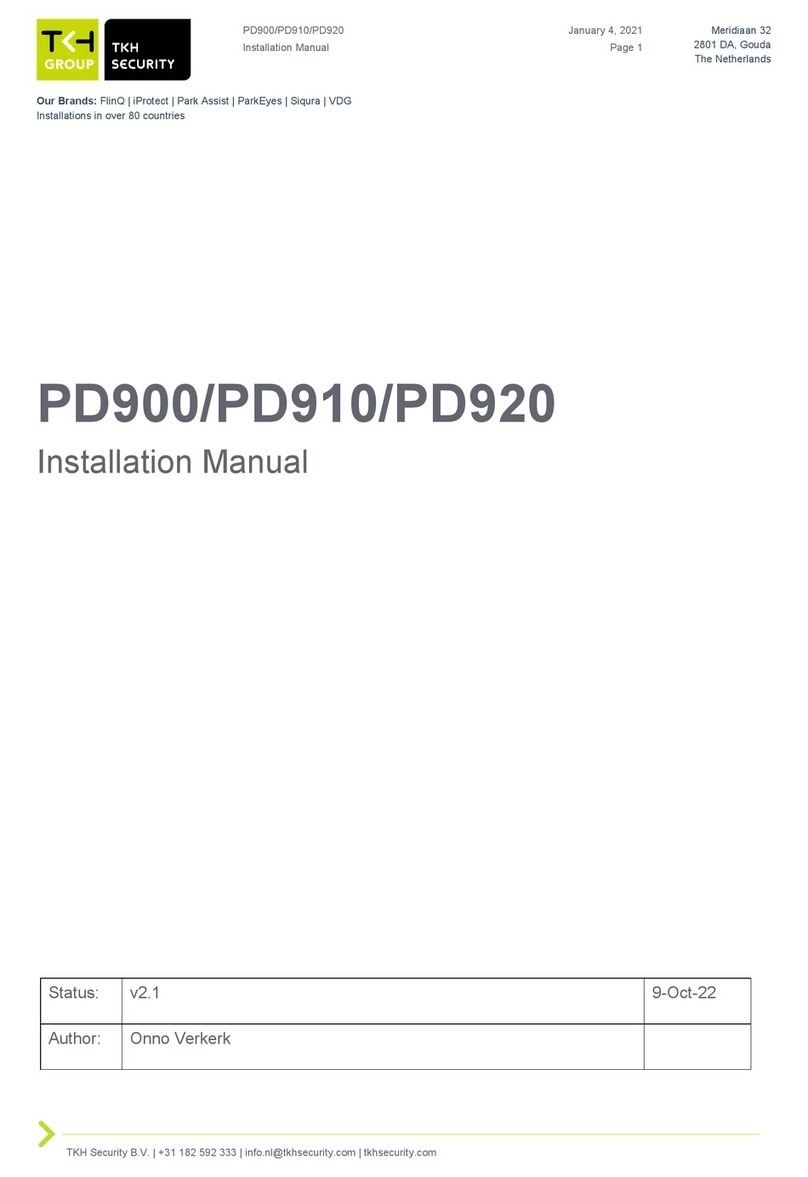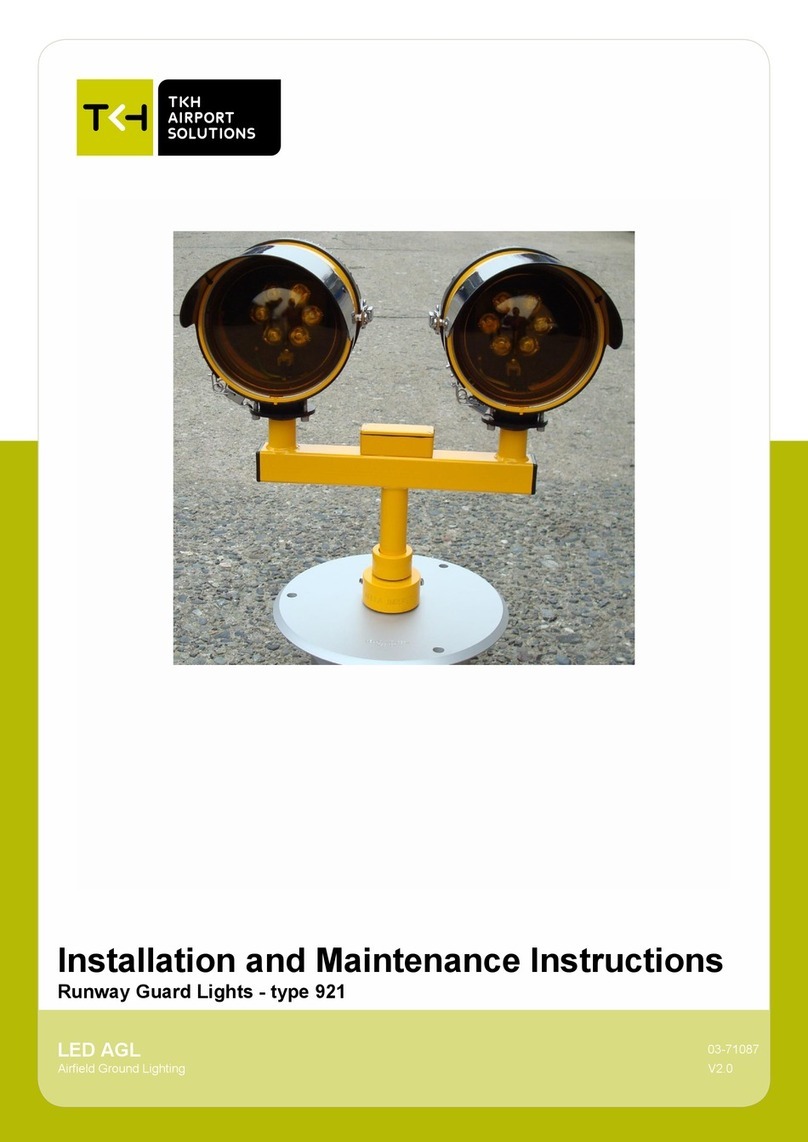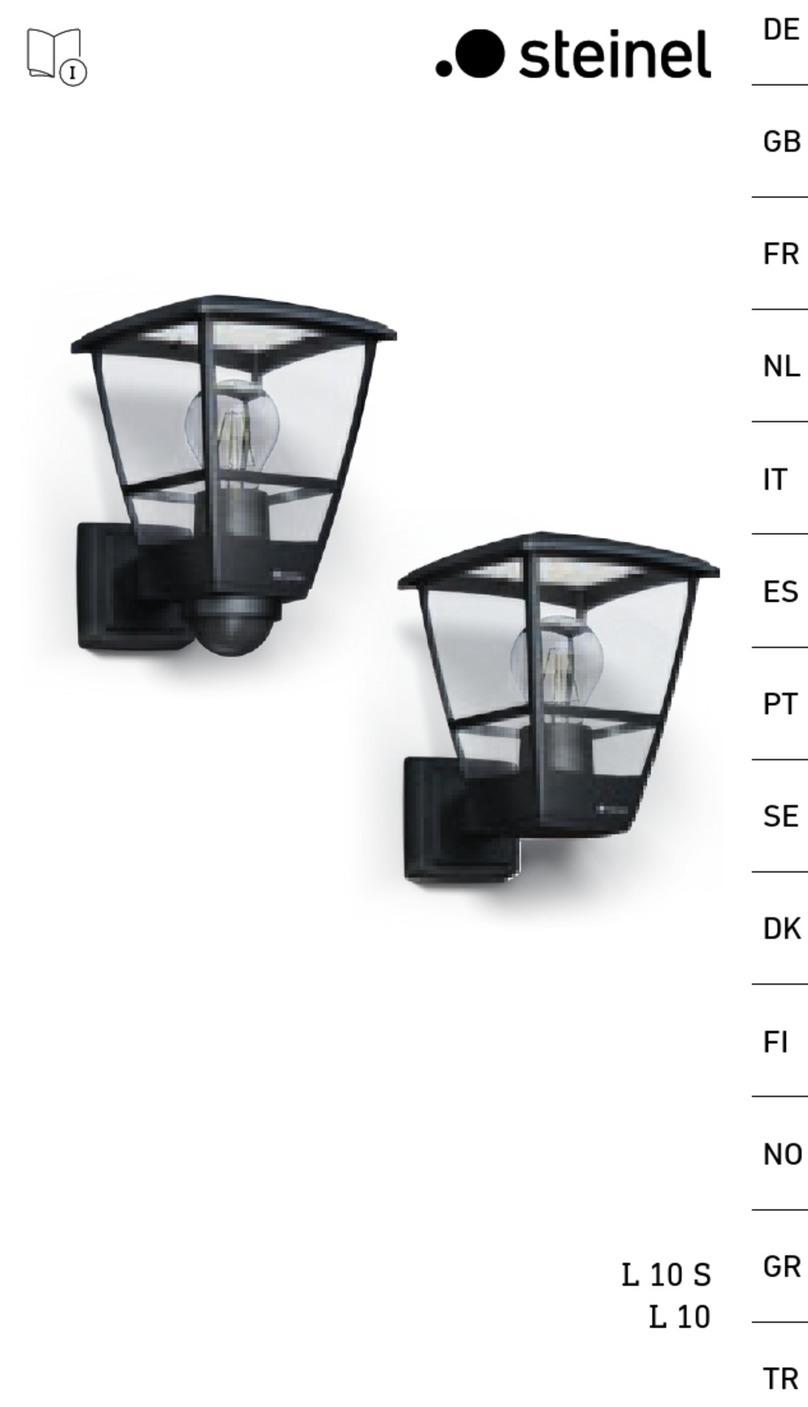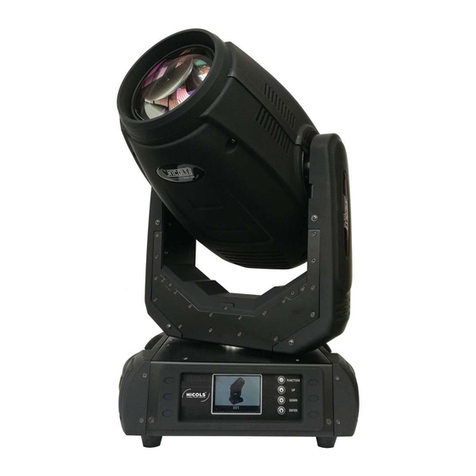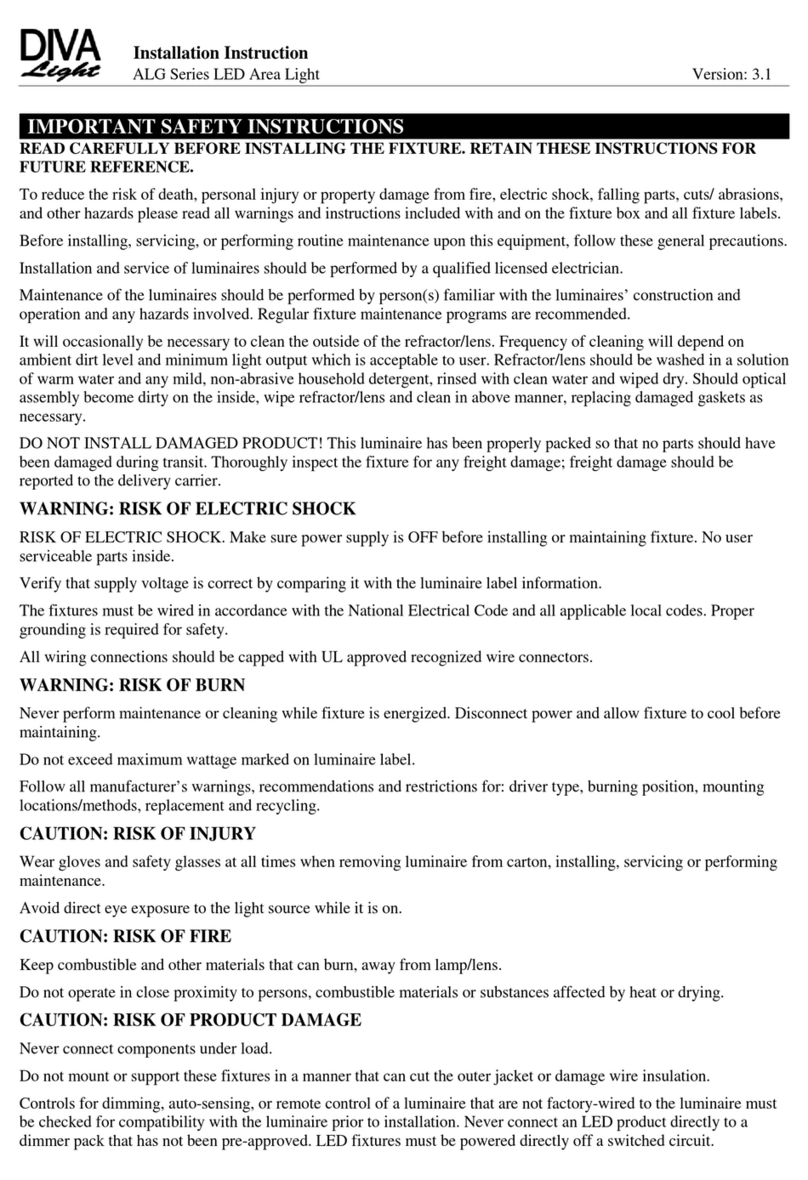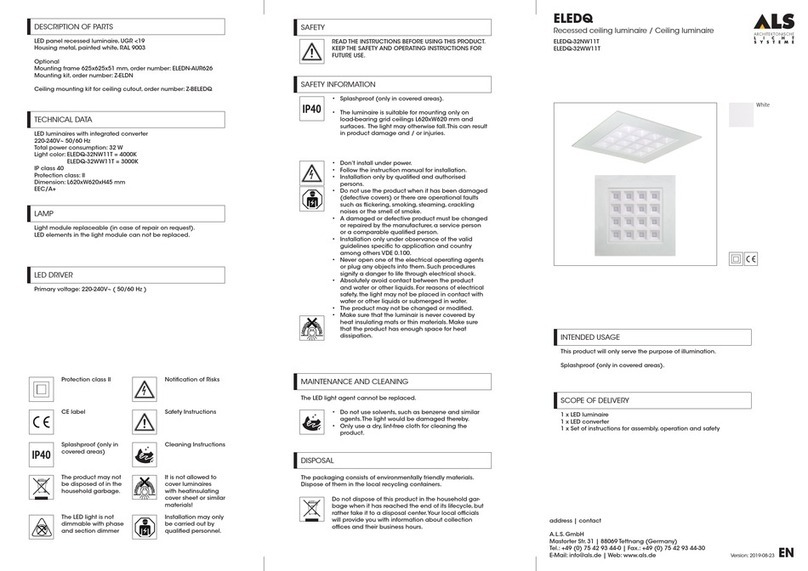TKH PAPI 801 User manual

CEDD AGL
Airfield Ground Lighting
Installation and Maintenance Instructions
PAPI Halogen (801)
03-71093
V2.2
HALOGEN AGL
Airfield Ground Lighting

©TKH Airport Solutions 2023. All rights reserved. All specifications subject to change without notice.
2
Preface
•Please read carefully and understand the contents of this manual.
•Failure to read the manual may result in serious injury, or serious damage to equipment.
•Make sure these instructions are always accessible for all users and ensure that you have read and
understood the contents.
Document Information
Name : 05_HALOGEN_AGL_PAPI_801_User_Manual_03-71093_V2.2
Version
Date
Description
V2.2
28.11.2023
Original
For the latest version of this document see https://www.tkh-airportsolutions.com/airfield-products/ or scan:
Copyright © TKH Airport Solutions 2023
All rights reserved for TKH Airport Solutions. No part of this publication may be reproduced, modified, stored in a retrieval system, or
transmitted, by any means or in any form without the written permission of the copyright owner.
The content of this document is property of TKH Airport Solutions. Proprietary rights of TKH Airport Solutions B.V. or USE System
Engineering Holding B.V. or their affiliated companies include the following: The specified (product) information herein and all related data
and information are proprietary and confidential to TKH Airport Solutions B.V. or USE System Engineering Holding B.V. and are the
subject of trade secrets and copy licensed from TKH Airport Solutions B.V. or USE System Engineering Holding B.V. The related data and
information are provided in confidence, and all use, disclosure, copying, transfer and storage, except as authorized in the written License
Agreement from TKH Airport Solutions B.V or USE System Engineering Holding B.V. to the user, is strictly prohibited.
The English version of this document is the original version; this language version is verified by the manufacturer. All other language
versions are translations of the original English language version.

©TKH Airport Solutions 2023. All rights reserved. All specifications subject to change without notice.
3
Contents
1. About this manual ........................................................................................................................................... 4
1.1 Symbols used...................................................................................................................................... 4
1.2 Storing the manual.............................................................................................................................. 5
1.3 Limitations of the Document ............................................................................................................... 5
1.4 Terms and Abbreviations.................................................................................................................... 6
1.5 Liability and Warranty.......................................................................................................................... 6
1.6 Manufacturer Details........................................................................................................................... 6
2. Safety.............................................................................................................................................................. 7
2.1 Safety.................................................................................................................................................. 7
2.2 Qualified Personnel............................................................................................................................. 7
2.3 Intended use ....................................................................................................................................... 8
2.4 Installation........................................................................................................................................... 8
2.5 Operation ............................................................................................................................................ 9
2.6 Action in the event of a system or component malfunction ................................................................ 9
3. General Recommendations .......................................................................................................................... 10
3.1 Receiving, Storage and Unpacking................................................................................................... 10
3.2 Electrical Connection ........................................................................................................................ 10
3.3 Base Earthing.................................................................................................................................... 10
4. About the PAPI 801....................................................................................................................................... 11
4.1 Mode of Operation ............................................................................................................................ 12
5. Description of the PAPI unit.......................................................................................................................... 13
5.1 PAPI specification ............................................................................................................................. 13
5.2 Assembly Drawing ............................................................................................................................ 15
5.3 List of spare parts.............................................................................................................................. 15
6. Installation and Maintenance ........................................................................................................................ 17
6.1 Installation instructions...................................................................................................................... 17
6.2 Adjusting the correct light output plane............................................................................................. 18
6.3 Adjusting the red filter ....................................................................................................................... 19
6.4 Maintenance...................................................................................................................................... 20
6.5 Replacing the red filter...................................................................................................................... 21

©TKH Airport Solutions 2023. All rights reserved. All specifications subject to change without notice.
4
1. About this manual
This manual contains technical information about the PAPI System (801). The manual is intended to be used
for installation and maintenance of the PAPI units in a PAPI system with four or eight units, or in an APAPI
system with two PAPI units.
1.1 Symbols used
The following marking conventions are used in this manual to draw attention to specific topics or actions:
DANGER! - This sign indicates a hazardous situation that, if not avoided,
will result in death or serious injury.
WARNING - This sign indicates a hazardous situation that, if not avoided,
could result in death or serious injury.
CAUTION - This sign indicates a hazardous situation that, if not avoided,
could result in minor or moderate injury.
NOTICE - is used in this manual to indicate a situation that could result in
damage to property or equipment.
The following symbols are used in pictures for explanation or an action:

©TKH Airport Solutions 2023. All rights reserved. All specifications subject to change without notice.
5
The following symbols are used on equipment and in this manual to warn of potential hazards:
DANGER of electrical shock or arc flash. Failure to observe this warning
will result in serious injury or death.
WARNING or CAUTION: where this symbol is used on the equipment, it is
mandatory to consult the manual to find out the nature of potential hazards
and any actions which have to be taken to avoid them.
1.2 Storing the manual
•This manual is a part of your product. Store the manual in a location that can be easily accessed by
personnel working on the product.
•It is the responsibility of the company operating this equipment to ensure that its personnel is provided
with a copy of this manual.
1.3 Limitations of the Document
TKH Airport Solutions reserves the right to revise this document without notification.
The data provided in this document is based on the most recent information at the time of publication. TKH
Airport Solutions is continually seeking to ensure that its products are developed to the latest technological
standards. As a result, it is possible that there may be some differences between the product and the
information in this manual.
For further information regarding adjustment, maintenance or repair which is not described in this document,
please contact the Customer Service department of TKH Airport Solutions.
The information in this document concentrates solely on use of the products as intended by the manufacturer.

©TKH Airport Solutions 2023. All rights reserved. All specifications subject to change without notice.
6
1.4 Terms and Abbreviations
This document may include the terms and abbreviations as listed below.
AGL Airfield Ground Lighting
EASA European Aviation Safety Agency
ICAO International Civil Aviation Organization
IEC International Electrotechnical Committee
LED Light Emitting Diode
PAPI Precision Approach Path Indicator
APAPI Abbreviated Precision Approach Path Indicator
1.5 Liability and Warranty
TKH Airport Solutions cannot be held responsible for injuries or damage resulting from non-standard,
unintended use, faulty or improper installation of its equipment, or failure to follow the instructions and safety
guidelines in this manual. The safety of any system incorporating the PAPI System (801) is the responsibility of
any site installation, commissioning, maintenance, and operational personnel using the system.
Disregarding the safety instructions in this manual will result in the loss of
warranty in case of damage.
Refer to the general TKH Airport Solutions Terms and Conditions document supplied with your sales order
contract for a complete liability and warranty description.
1.6 Manufacturer Details
TKH Airport Solutions
Elektrostraat 17
7483 PG Haaksbergen
The Netherlands
•Tel.: +31 (0)53 5741456
•Email: info@tkh-airportsolutions.com
•Internet: www.tkh-airportsolutions.com
For service requests, please contact the TKH Airport Solutions Customer Service department:
•Email: service@tkh-airportsolutions.com

©TKH Airport Solutions 2023. All rights reserved. All specifications subject to change without notice.
7
2. Safety
2.1 Safety
This section contains general safety instructions for using your TKH Airport
Solutions equipment. Some safety instructions may not apply to the
equipment in this manual. Note all warnings and follow all instructions
carefully. Failure to do so may result in personal injury, death, or property
damage.
To use this equipment safely,
•Refer to the International Standard IEC 61820, Electrical installation for lighting and beaconing of
aerodromes - Constant current series circuits for aeronautical ground lighting - System design and
installation requirements, and to the International Standard IEC 61821, Electrical installations for lighting
and beaconing of aerodromes - Maintenance of aeronautical ground lighting constant current series
circuits for instructions on safety precautions.
•Observe all safety regulations. To avoid injuries, always remove power prior to making any wire
connections and touching any live part. Refer to the International Standards IEC 61820 & IEC 61821.
•Read and become familiar with the general safety instructions provided in this section of the manual
before installing, operating, maintaining, or repairing this equipment.
•Read and carefully follow the instructions given throughout this manual for performing specific tasks and
working with specific equipment.
•Store this manual within easy reach of personnel installing, operating, maintaining, or repairing this
equipment.
•Follow all applicable safety procedures required by your company, industry standards, and government
or other regulatory agencies.
2.2 Qualified Personnel
The term "qualified personnel" is defined here as a person who thoroughly understands the equipment and its
safe installation, operation, maintenance, and repair. Qualified personnel are physically capable of performing
the required tasks, familiar with all relevant safety rules and regulations, and have been trained to safely install,
operate, maintain, and repair the equipment. It is the responsibility of the company installing, operating or
maintaining this equipment to ensure that its personnel meet these requirements.

©TKH Airport Solutions 2023. All rights reserved. All specifications subject to change without notice.
8
2.3 Intended use
Use of this equipment in ways other than described in the datasheet and
this manual may result in personal injury, death, or property damage. TKH
Airport Solutions cannot be held responsible for injuries or damage
resulting from non-standard, unintended application of its equipment. This
equipment is designed and intended only for the purpose described in this
manual. Uses not described in this manual are considered to be
unintended use. Unintended use may result from taking the following
actions:
•making changes to equipment that have not been recommended or described in this manual or using
parts that are not genuine TKH Airport Solutions replacement parts or accessories
•using materials or auxiliary equipment that are inappropriate or incompatible with your TKH Airport
Solutions equipment
•allowing unqualified personnel to perform any task
2.4 Installation
A thorough understanding of system components and their requirements
will help you install the system safely and efficiently. Failure to follow these
safety procedures can result in personal injury or death.
Read the safety and installation sections of all system component manuals
before installing your equipment.
•Allow only qualified personnel to install TKH Airport Solutions equipment and auxiliary equipment. Use
only approved equipment. Using unapproved equipment in an approved system may void agency
approvals and will void the warranty.
•Make sure all equipment is rated and approved for the environment in which you are using it.
•Follow all instructions for installing components and accessories.
•Do not hold or carry the light assemblies by the cables.
•Install all electrical connections according to to local codes and regulations, provided they are not in
contradiction with the general rules.
•Use only electrical wire of sufficient gauge and insulation to handle the rated current and voltage
demand. All wiring must meet local codes.
•Route electrical wiring along a protected path. Make sure the wires will not be damaged by moving
equipment and animals (e.g. rodents).
•Protect components from damage, wear, and harsh environmental conditions.
•Allow sufficient room for maintenance, panel accessibility (power products), and cover removal (power
products).
•Protect equipment with safety devices as specified by applicable safety regulations.
•If safety devices must be removed for maintenance, re-install them immediately after the work is
completed and check them for proper functioning.

©TKH Airport Solutions 2023. All rights reserved. All specifications subject to change without notice.
9
2.5 Operation
Only qualified personnel (see section 2.2 Qualified Personnel) should
operate this equipment. Read all system component manuals before
operating this equipment. A thorough understanding of system components
and their operation will help you operate the system safely and efficiently.
•Before starting this equipment, check all safety interlocks, fire-detection systems, and protective devices
such as panels and covers. Make sure all devices are fully functional. Do not operate the system if these
devices are not working properly. Do not deactivate or bypass automatic safety interlocks or locked-out
electrical disconnects or pneumatic valves.
•Never operate equipment with a known malfunction.
•Do not attempt to operate or service electrical equipment if standing water is present.
•Use this equipment only in the environments for which it is rated. Do not operate this equipment in humid,
flammable, or explosive environments unless it has been rated for safe operation in these environments.
•Never touch exposed electrical connections on equipment while the power is ON.
•Never look directly in the light source while the power is ON.
•For fixtures/spare parts marked with the photobiological safety symbol avoid prolonged staring in the
switched ON fixture.
2.6 Action in the event of a system or component malfunction
Do not operate a system that contains malfunctioning components. If a
component malfunctions, turn the system OFF immediately.
•Disconnect and lock out electrical power.
•Allow only qualified personnel to make repairs. Repair or replace the malfunctioning component
according to instructions provided in its manual. Allow only qualified personnel to perform maintenance,
troubleshooting, and repair tasks. Only persons who are properly trained and familiar with TKH Airport
Solutions equipment are permitted to service this equipment.
•Follow the recommended maintenance procedures in your equipment manuals.
•Connect all disconnected equipment ground cables and wires after servicing equipment. Ground all
conductive equipment.
•Use only approved TKH Airport Solutions replacement parts. Using unapproved parts or making
unapproved modifications to equipment may void agency approvals, impair specified performance and
create safety hazards.
•Check interlock systems periodically to ensure their effectiveness.
•Do not attempt to service electrical equipment if standing water is present. Use caution when servicing
electrical equipment in a high-humidity environment.
•Use tools with insulated handles when working with electrical equipment.

©TKH Airport Solutions 2023. All rights reserved. All specifications subject to change without notice.
10
3. General Recommendations
3.1 Receiving, Storage and Unpacking
1 Upon receipt of goods at the site store, check all packaging for visible damage. Every damaged box
should be opened and its contents inspected for damage. If equipment is damaged, a claim form shall
be filled with the carrier immediately. It may then be necessary for the carrier to inspect the equipment.
2 Store the light assembly preferably in its original packaging in a protected area. When stored unpacked,
please take care not to damage the cable insulation.
3 Unpack the light assembly at the installation site to avoid damage during transportation and handling.
3.2 Electrical Connection
The light assemblies covered by this manual are designed for connection to 6.6-A series circuits via one or two
L-830 or L-831 series transformers. The current to the light should not exceed 6.6 A + 5%. The series
transformers are to be ordered separately.
3.3 Base Earthing
Whatever the chosen installation method, it is strongly recommended to earth the base, especially in locations
presenting a risk of lightning strikes. Failure to earth the base correctly will void the warranty for all damages
occurring as a result of voltage surges.

©TKH Airport Solutions 2023. All rights reserved. All specifications subject to change without notice.
11
4. About the PAPI 801
The PAPI system is a simple and reliable visual aid which enables the pilot to establish and maintain an exact
glide path. The system secures the safe and accurate guidance for the pilot throughout the final approach
phase to touch-down, both day and night.
A standard PAPI system comprises a wing bar of 4 light units located alongside the runway on its left, at the
glide path origin and facing the approach. If further horizontal guidance is required, a second wing bar on the
opposite side of the runway can be established.
An APAPI system comprises a wing bar of 2 light units.
On approach, pilots are presented with a red/white light pattern that informs them instantly of their vertical
position relative to the designated glide path, enabling them to adjust the rate of descent to acquire the correct
glide slope or, if necessary, fly a low or high approach in complete safety.
PAPI and APAPI Light pattern
This TKH Airport Solutions PAPI 801 can be supplied as 2-light units (2 x 200W Pk30d) or as 3-light units (3 x
200W Pk30d). As an option, the units can be supplied with heating elements on the lenses to prevent ice and /
or mist.

©TKH Airport Solutions 2023. All rights reserved. All specifications subject to change without notice.
12
4.1 Mode of Operation
The optical system divides the light beam of the units in an upper half showing white and a lower half showing
red. The transition at the centre of the vertical range is of so short a duration that the lights give an eye-
catching click within a range of less than 3 minutes of arc.
Schematic illustration of the PAPI operation
Location on the Field
PAPI
APAPI
1.
9 m +/- 1 m
1.
6 m +/- 1 m
2.
9 m +/- 1 m
2.
10 m +/- 1 m
3.
9 m +/- 1 m
4.
15 m +/- 1 m
Light beam angles for each light need to be calculated for the airfield,
depending on ILS and approach angles.

©TKH Airport Solutions 2023. All rights reserved. All specifications subject to change without notice.
13
5. Description of the PAPI unit
The main parts in PAPI units are as follows:
•Stainless steel housing
•Stainless steel cover
•3-legged bottom frame, with adjustable legs.
•Lenses
•Red filters with eccentrics for adjustments
•Halogen light sources
•Aluminium reflectors
•Control display for angle adjustment
The PAPI unit is constructed and adjusted to
have the centre of the lamp, edge of red filter,
and centre of lens in one line to secure the sharp
transition.
In the factory, the PAPI unit is adjusted to 0° in
both light directions and perpendicular to the light direction (measured on the control display). The following
are checked and adjusted in that position:
•Light output is also 0°
•Transition sector is completely identical for all (2 or 3) light systems in the PAPI unit
•The transition sector is horizontal
The PAPI unit is now adjusted to a sharp transition between red and white, and the angle on the control
display will be the same as the angle of the light output.
The angle of the light output can now be adjusted by setting the position of the ball joint on the back leg.
5.1 PAPI specification
•The PAPI units can be supplied with light plane height above ground between 350mm and 700mm. The
standard value is 550mm. The height can typically be adjusted ± 20 mm.
•Light output app. 35.000cd (white) / 10.000cd (red) for one 200W light system. To be multiplied with 2,
respectively 3 dependant on the number of lamps in the PAPI unit.
•Lamps: 200W-6,6A- Pk30d-1000Hour
•Weight approximately 40 KG
•Cover in aviation yellow, the rest is black.
•Breakable coupling included
•Foundation bolts are not included as standard. Standard 16mm hot dip galvanized bolts with accessories
can be used or we can offer a stainless foundation kit type 801.530
•Cable entry for each lamp through PG 13,5 gland. Connection directly to male connector on Pk30 bulb as
standard.
•Optional FAA cable can be supplied in length according to customer request
•The PAPI light fixture can optionally be equipped with a heater system including a heater for each lens
and a thermostat. Total power is 75W with an input voltage of 48VAC. The heater kit is to order as type
801.845.

©TKH Airport Solutions 2023. All rights reserved. All specifications subject to change without notice.
14

©TKH Airport Solutions 2023. All rights reserved. All specifications subject to change without notice.
15
5.2 Assembly Drawing
5.3 List of spare parts
Item
Description
Article number
1
Bottom frame
952204/2
2
Breakable coupling
952210/60-120
3
Pipe
952.217.0
4
Nut ½"
P-900515
5
Ball bolt
801203
6.1
Fitting PG 13,5
P-242032
6.2
Protection tube
P-242031
7
Ball bearing
801202
8
Top gasket
9.1
Hook for Lock
P-855503
9.2
Lock without hook
P-855504
9.3
Pin for lock
P-855505
10
Spring for lamp holder
801419
11
Lamp holder
801418
12
Reflector
801416
13
Reflector holder threads
801406
14
Reflector housing
801815

©TKH Airport Solutions 2023. All rights reserved. All specifications subject to change without notice.
16
Item
Description
Article number
15
Filter holder
801412
16
Spring for filter
801410
17
Red light filter
801432
18
Cover / Lid
801814/6
19
Housing
801810/4
20
Lens Ø150
801401
21
Lens holder ring
801403/1
22
FAA cable 2 pol 0.9 m
P-242010
23
Heater system for Halogen PAPI, 3 x 25 W - 42 V*
801845
24
Filter adjustment piece
801413
25
Adjustment holder
801414
26
Back plate for reflectors
801817
27
Ball joint
801222
28
Lamp PK 30d 200 W
P-383007
29
Anchor bolt
801530
30
Angle piece
40-5769
31
Adjustment bar
40-5964
32
Rubber gasket for lens
801433
* Heating system is an option
When the PAPI 801 is configured with 2 lights, a cover plate is mounted in
the center position.

©TKH Airport Solutions 2023. All rights reserved. All specifications subject to change without notice.
17
6. Installation and Maintenance
Before any maintenance is done to the PAPI 801, the main power must be
switched off.
6.1 Installation instructions
If the runway has ILS, the TDZ point for the PAPI system must be the same as the theoretical TDZ point for the
ILS.
If not, the airport authorities can determine the TDZ point, or the minimum distance from the Threshold can be
calculated as follows:
1. The minimum Threshold clearance is 15m.
Runway is horizontal:
Distance from Threshold = L (in m) => L = 15 / tan (α), where α = glide slope angle
2. TDZ is D (in m) lower than Threshold:
Distance from Threshold = L (in m) => L = (15+D) / tan (α), where α = glide slope angle
3. TDZ is D (in m) higher than Threshold:
Distance from Threshold = L (in m) => L = (15-D) / tan (α), where α = glide slope angle
Placed in the TDZ point the PAPI units must have their light output center the light plane in level with the
center of the runway. It means that the top of the foundation must be 550 mm (for a standard height of PAPI
units) lower than the center of the runway. If that is not possible either the TDZ point or the PAPI units must be
displaced.
1. Mount each PAPI unit on a stable concrete foundation by means of 3 anchor bolts. The light output
must be parallel to the runway or have a very small toe-in.
2. Mount the PAPI units on the anchor bolts.
3. Level the bottom frame.
4. By means of the ball joints on each leg, adjust the PAPI unit to the correct light output plane with
the housing approximately levelled.

©TKH Airport Solutions 2023. All rights reserved. All specifications subject to change without notice.
18
6.2 Adjusting the correct light output plane
The ball joints on the 3 legs are adjusted until the PAPI light unit has the correct light output level, and at the
same time the factory adjusted control plane in the PAPI unit is 0° in both light direction and perpendicular to
the light direction. This is measured by means of the high accuracy digital clinometers, see the following figure.
Then the digital clinometer is placed on the control plane in the light direction, and the ball joint on the back leg
is adjusted to the desired angel for each individual PAPI light unit. Be careful not to touch the housing during
the adjustment as angel adjustment is very sensitive.
Please read the manual for the digital clinometers carefully before use to know how to handle this very
sensitive, high-tech device. Please note, that the battery must be changed regularly to maintain the factory
calibration of the digital clinometers.

©TKH Airport Solutions 2023. All rights reserved. All specifications subject to change without notice.
19
6.3 Adjusting the red filter
The filters inside the PAPI can be adjusted in height and horizontal level.
Do not adjust the distance between the filters and the lamp housing. This
distance is pre-set in the factory and fixed.
A correct position of the filters can be seen from the front of the PAPI. The red filters should be aligned
correctly (shown is the PAPI with 2 lights).
The transition line in both the lenses must be at the same height. If not, the filters can be adjusted by eccentric
position screws. To adjust the transition line:
1. Switch the power off.
2. Lift the cover of the PAPI.
3. Adjust the adjustment screws (2) of the applicable filter (1). The adjustment screws (2) can be
found next to the rear side of the halogen bulbs (3).

©TKH Airport Solutions 2023. All rights reserved. All specifications subject to change without notice.
20
4. The adjustment screws are supporting the filter at two positions. The slots in where the filter is
supported are eccentric. By turning the adjustment screws (2) on the back of the PAPI, the filter
height (1) can be adjusted. The spring (3) keeps the filter in position onto the eccentrics (2).
5. When the position of the filter is okay, mount the cover of the PAPI.
6. Switch the power on and adjust the correct light output plane, see 6.2.
6.4 Maintenance
Once a month the PAPI light fixtures should be maintained and controlled as follows:
1. The lenses are cleaned.
2. Reflectors and filters are carefully cleaned with a dry, soft cloth. If a filter is damaged, replace it with
a new filter (see chapter 6.5).
3. Make sure, that the filters are in the correct position in the slots of the eccentric adjustment screws.
If not, adjust the filter (see chapter 6.3).
4. Check that the lamps are working, and that the filament in the lamps is in the correct position (if the
filament in the lamp starts “hanging” the transition sector for the actual light output will have
moved).
5. Use the digital clinometers to control the setting of each PAPI unit, both in the light direction and
perpendicular to the light direction.
6. Switch on the PAPI light in the highest intensity step, and look at the light output from the longest
distance, where the transition from white to red can be seen. The transition must be sharp and
simultaneous for all light system in the PAPI unit.
a. If not, control the position of the filters or
b. Change the lamps (be careful to place the lamp correct)
Table of contents
Other TKH Lighting Equipment manuals
Popular Lighting Equipment manuals by other brands
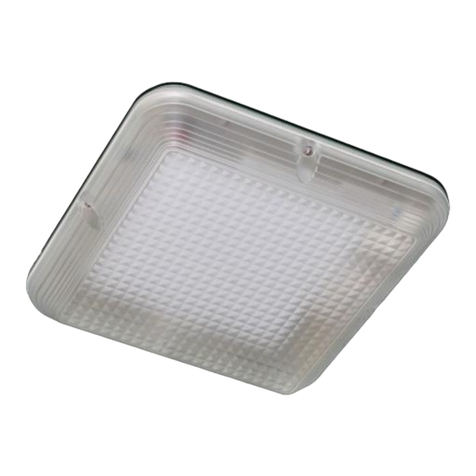
Clevertronics
Clevertronics LP CWSQLED Series ASSEMBLY, INSTALLATION & MAINTENANCE INSTRUCTIONS

Aqua Creek Products
Aqua Creek Products MIGHTY 400-BLUE manual
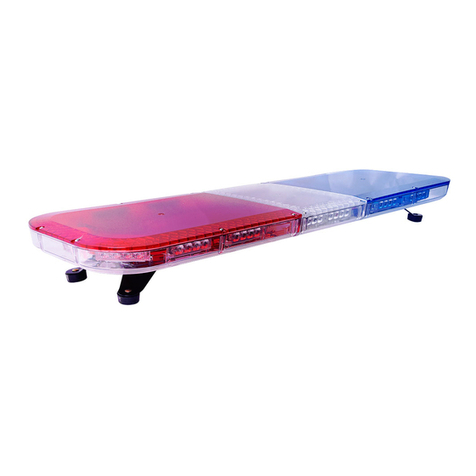
Epcom
Epcom X67RB user manual

American DJ
American DJ X-Treme/AS User instructions
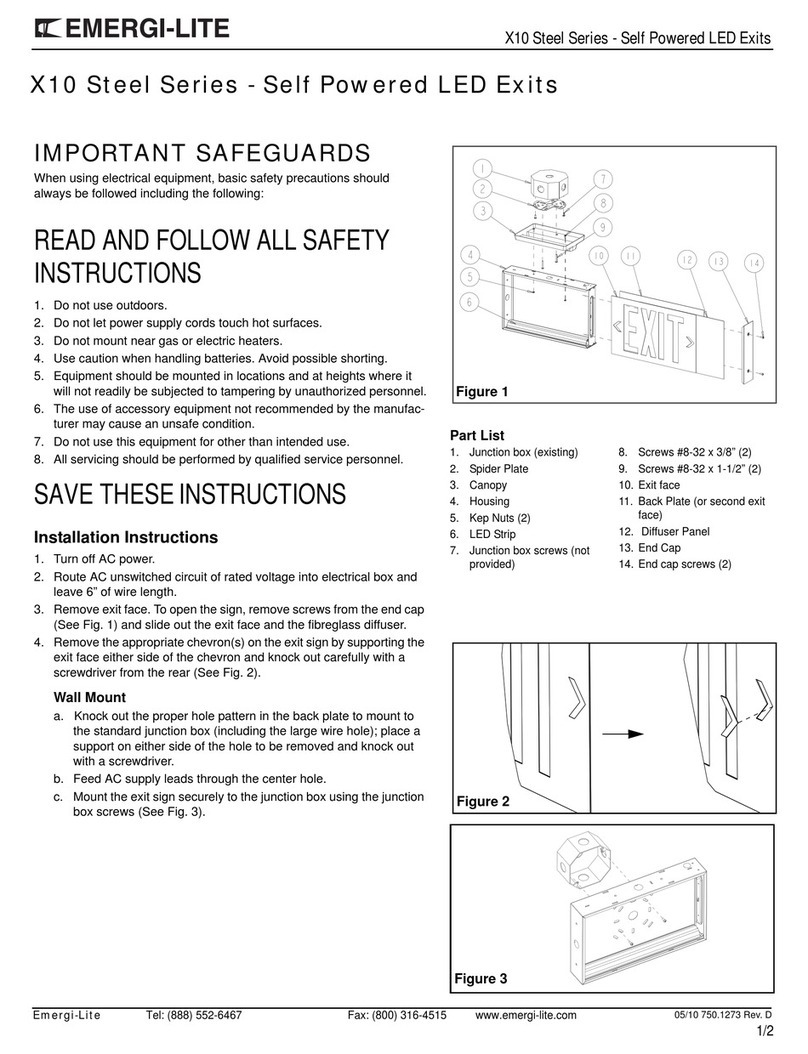
Emergi-Lite
Emergi-Lite X10 Steel Series manual
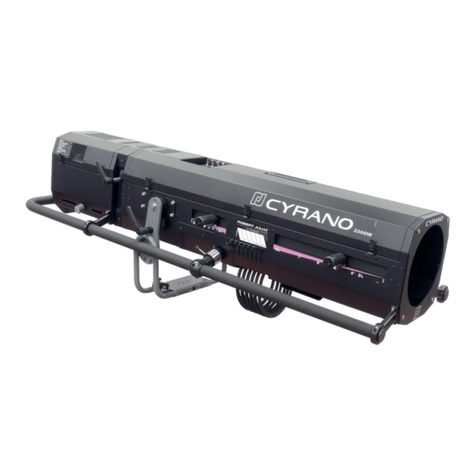
Robert Juliat
Robert Juliat 1015 B Technical manual
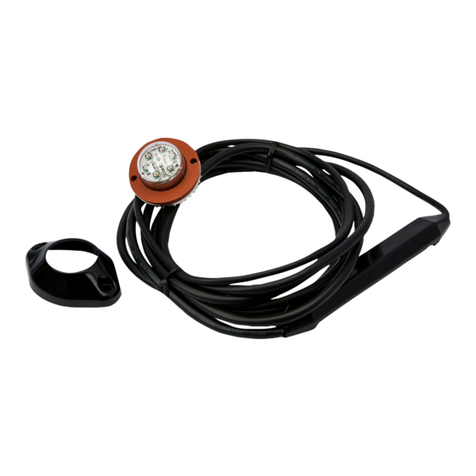
Ecco
Ecco Hide-A-LED 9014 installation instructions
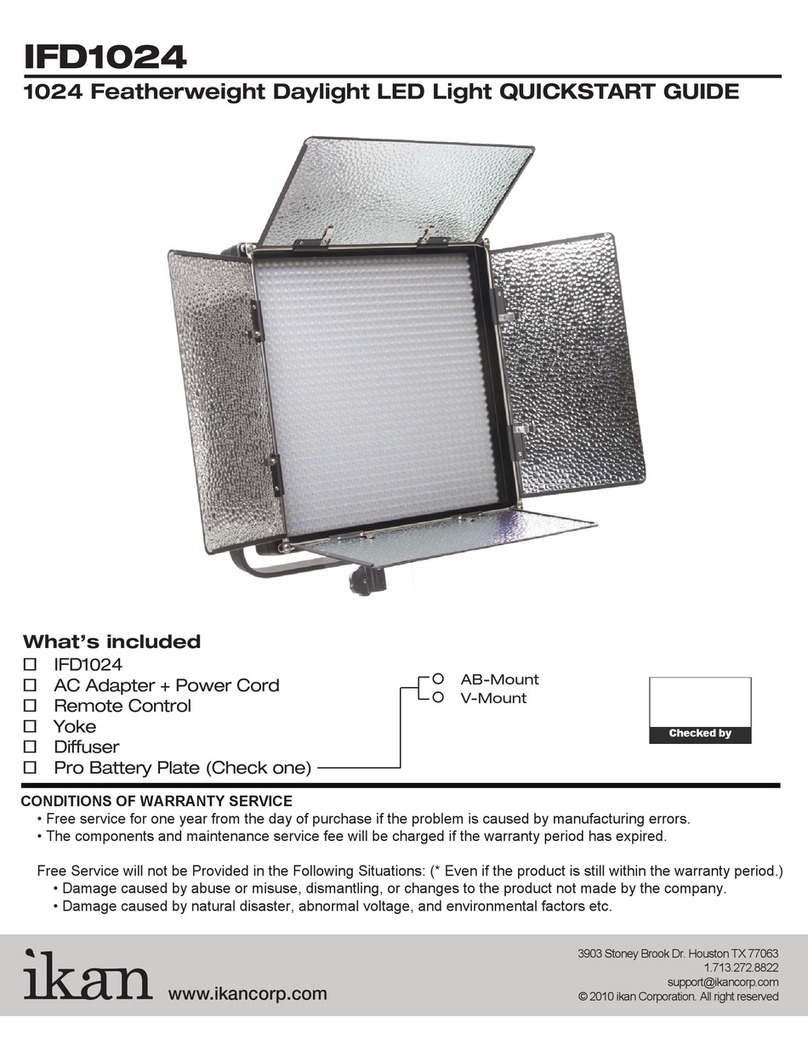
Ikan
Ikan IFD1024 quick start guide
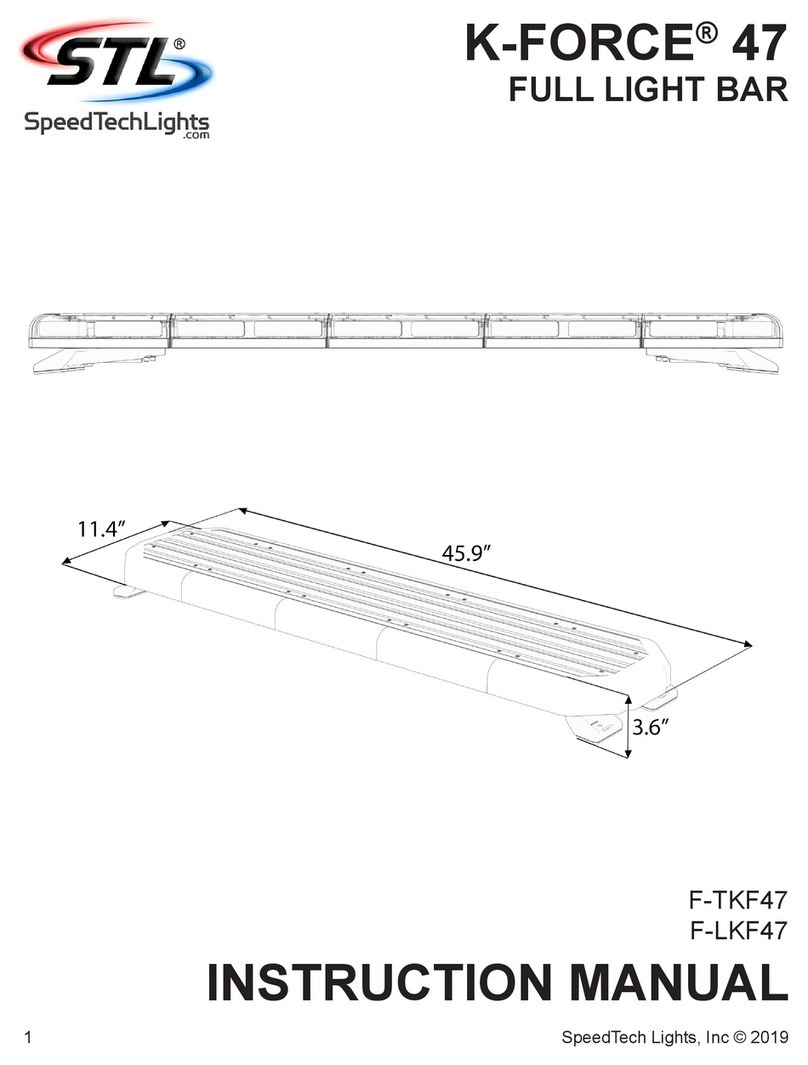
STL
STL K-FORCE F-LKF47 instruction manual
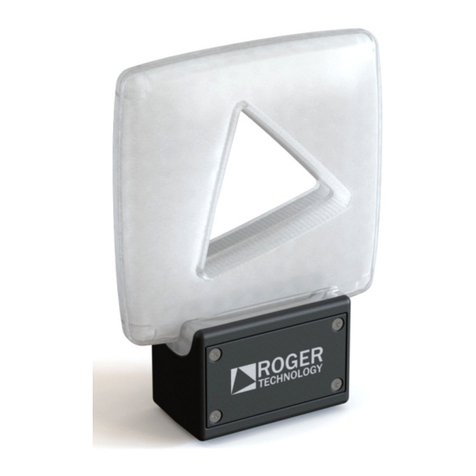
Roger Technology
Roger Technology FIFTHY/24 Instruction and warnings for the installer
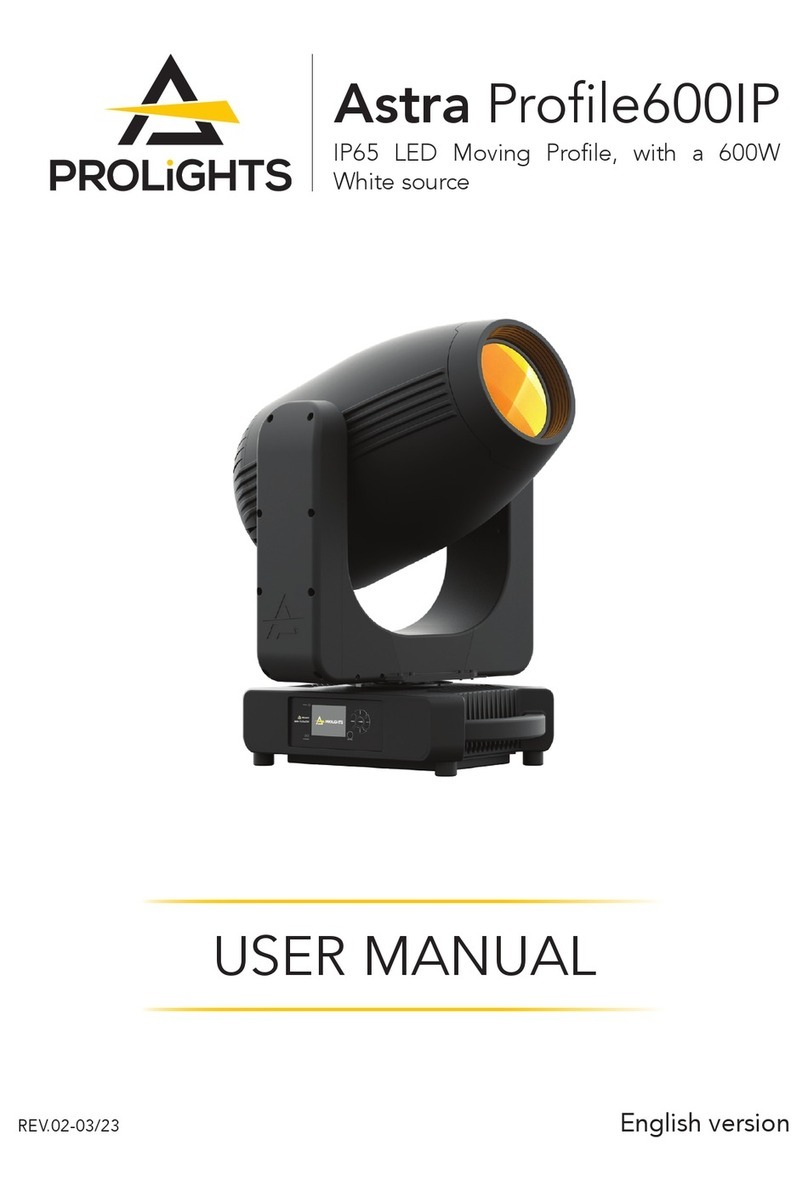
ProLights
ProLights Astra Profile600IP user manual

Ballard Designs
Ballard Designs LL323 quick start guide
